So you’re ready to learn how to pan for gold. Great! You can make a great deal of money if you pick the right areas to prospect for gold. In this guide, I will explain to you how to go about panning for gold and what tools you need to get started.
Follow along, print this article and bring it along on your next gold panning expedition. If you follow these steps you just might hit your big payday!
How to Pan For Gold
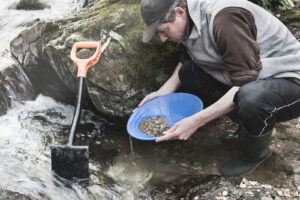
Before we get started you will need some essential gold panning tools. There are ten tools you need. In this list, I’m not including big equipment. These are the tools a novice gold prospector would use in the field.
Not all of these tools are necessary but they will come in handy at various stages of the gold prospecting process so I do recommend you have them with to make your gold panning go more smoothly.
Gold Panning Tools
- Gold Pan
- Spaded Shovel
- Classifier
- Pickaxe or Mattock
- Jewelers Loupe
- Tweezers
- Snifter Bottle
- Magnet
- Storage Container
- Seat
Picking a Location To Prospect

The next thing you need to do once you have your gold panning equipment is to locate a creek, river or stream where you think gold might be hidden.
If you can find a spot to pan that has been known to contain gold in the past then go with that. Don’t think that spot might be panned out because every time you get heavy rains and floods gold will break loose of the bedrock and flow downstream.
But if you can’t find a location like that in your area you will need to do some test panning.
Some other things to consider when choosing a gold panning location is if it is public land check with whatever agency that is in charge of the location to make sure you are allowed to pan for gold in that stream or river. If there is a mining claim on the land then you won’t be able to pan there.
If you are going to be panning on private land make sure to get permission from the owner of the land so you don’t get shot at. A little gold isn’t worth getting killed over!
Deciding Where to Dig and Where to Pan
Once you have a location where you are going to prospect you will need to find two locations in that area. You want to find one spot to dig and one spot too, pan. Inside of bends where the water slows down is a good spot to dig because gold would accumulate there.
Another good spot to dig would be behind boulders or big rocks where gold can get trapped. Also, you will want to dig down deep in the stream bed especially where there is the presence of bedrock beneath then you want to dig all the way down to the bedrock where gold would most likely be trapped.
Now you want to find a place in the stream to actually do the panning. This is where the water comes into play. You want an area where the water is clear and deep enough to submerge the pan.
The water should be flowing freely so as to keep the water clear while you are panning. You don’t want a lot of mud and sediment accumulating in the water because you will have a hard time seeing what you are doing.
Sifting Out The Larger Debris
Now that you have found the spot where you would like to dig you can start digging. There are a few tools you will need in this step. You are going to need to get out your shovel, gold pan, and a classifier.
A clarifier is essential a big strainer that you will use to sift out the larger debris from the finer-grained dirt. Shovel the dirt into the classifier filling the clarifier to the top.
Next, get out your gold pan and place it under the classifier. Now having both the gold pan and the classifier submerged in the water at the spot you picked earlier you can start shaking the classifier letting the smaller grains of dirt fall that might hold gold into the gold pan.
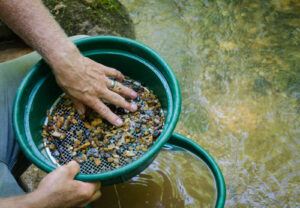
All that should be left in the classifier are the big rock. Carefully look through these bigger rocks before tossing them aside because you might find a big gold nugget amongst them.
If you have a metal detector you can just scan these rocks to find out if there are any gold ones there. You more than likely will not find any big gold nuggets but it doesn’t hurt to make sure. If none of the bigger rocks are not gold then you can toss them aside.
The mesh of classifiers can vary but I would recommend a mesh of about ½” works best for this process. You can experiment with different classifier mesh hole sizes to see what works best for you.
Most classifiers are designed to fit in the opening of a 5-gallon bucket. So you could get a 5-gallon bucket place the classifier on top and strain out the bigger rocks so that only the finer-grained dirt falls in the bucket. You would fill the bucket up with the panning dirt and then carry the bucket over to the spot where you will be panning.
Doing it that way will save you a lot of time going back and forth from the digging spot to the panning spot.
Panning For Gold
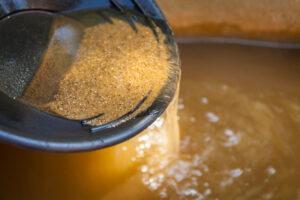
Once you have used the classifier to strain out the big rocks then you can start the panning process.
There are various ways taught about how to pan for gold. You will probably find when you go out in the field and start panning for yourself you will get your own unique technique down that works best for you. So there is no right or wrong way of doing it.
But I will explain one way of doing so that you get the basic idea of how to pan for gold.
First, find the current and submerge your gold pan all the way in the water. With the current coming at you tilt the gold pan just enough so that the current flows into the pan.
With the pan submerged in the water, you want to swirl the pan from side to side so that the contents flip around in the pan. The goal here is to get some of the gravel to fall out of the pan.
Be careful not to dump all the dirt from the pan out because then you will have to start the sifting process all over again.
Leveling Out The Contents
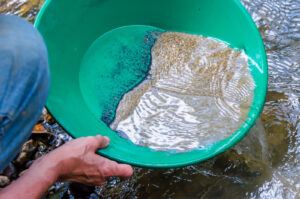
Now while the pan is still in the water you want to shake it back and forth. Doing this will level out the contents of the pan and it makes the gold settle to the bottom of the pan. You will do this many times until you have a small layer of dirt left in the pan.
What’s left in the pan are the heaviest of the finer-grained dirt. You will have black sand, various minerals and hopefully some gold left in the pan.
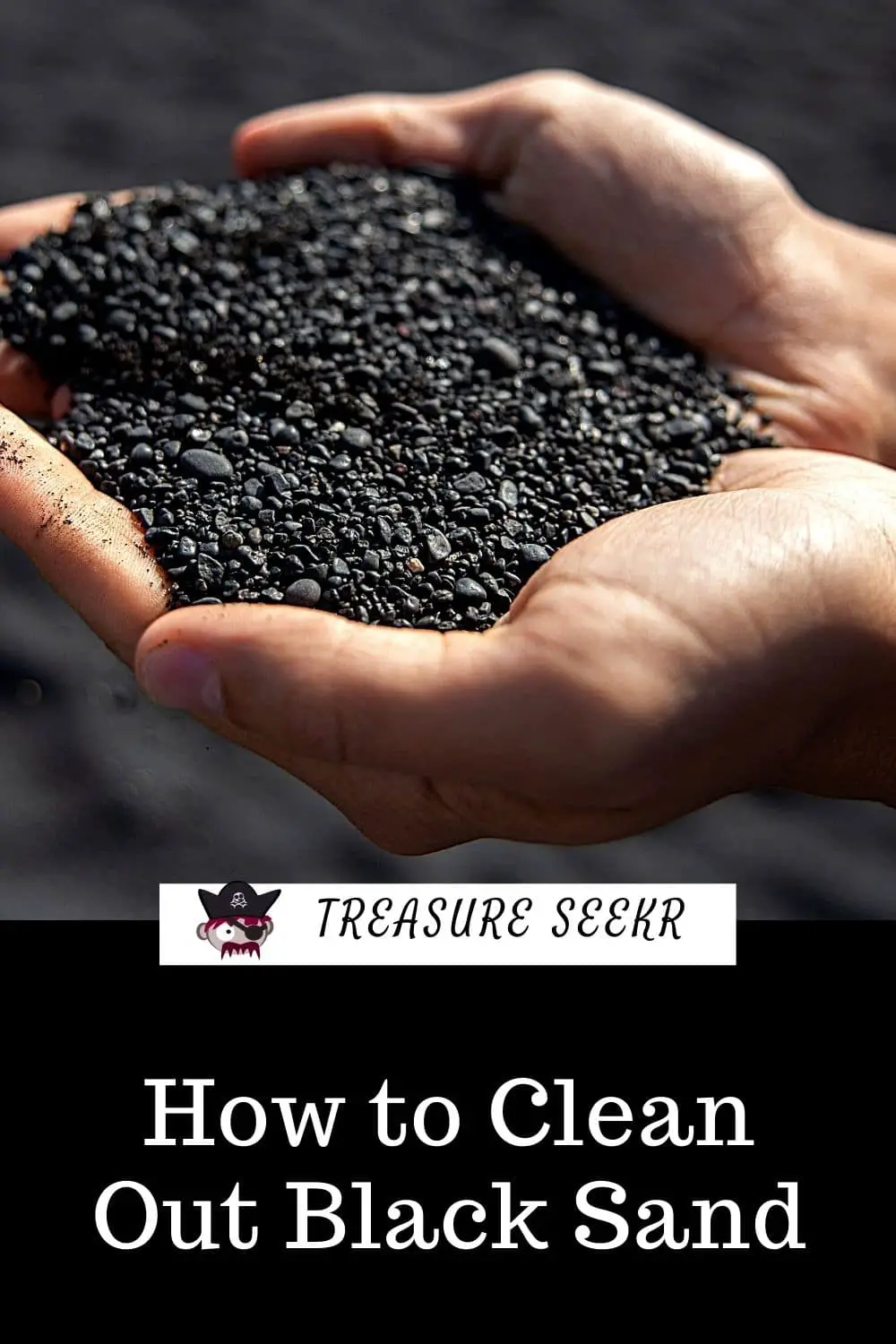 How to Clean Out Black Sand
How to Clean Out Black Sand
Now you will need to clean out the black sand from what’s left in the pan. Take the pan out of the water making sure there is a little water still left in the pan. While the gold pan is tilted swish the water and contents that are left in a circular motion.
By doing this you will be able to detect if there are any gold nuggets in the pan and if you see them you can pick them out by hand.
Now you can repeat the leveling and shaking process a few times making sure you don’t over swirl the pan which would cause you to lose some gold. After you have done this a few times you will hopefully end up with some gold dust left in the bottom of the pan.
If you’re using a plastic gold pan you can get out a magnet wave it around inside the pan. The magnet will attract the black sand because it’s magnetic and separate it from the gold.
If you have hit paydirt then there will be some gold left in the pan. To get the gold out of the pan you want to get a snifter bottle.
These bottles have a suction tube at the opening and when you squeeze the bottle you create a vacuum that when released will suck the gold into the bottle along with any water leftover.
Eureka! There’s Gold In Them There Hills

Hopefully, at the end of the day, you will come home with some gold. Like I said earlier in this article you will probably come up with your own technique of panning but this should give you an idea of how to start panning for gold and you can go from there.
So get out there and start prospecting for gold! The more often you pan the better you will get at it. Even if you don’t find any gold it’s still a fun pastime and just the chance of finding gold is fun and exciting.
I hope you got some informative details that will help you get started prospecting for gold. If you have any questions or comments please leave them in the comments section below. Thanks for reading and as always Happy Treasure Hunting!
